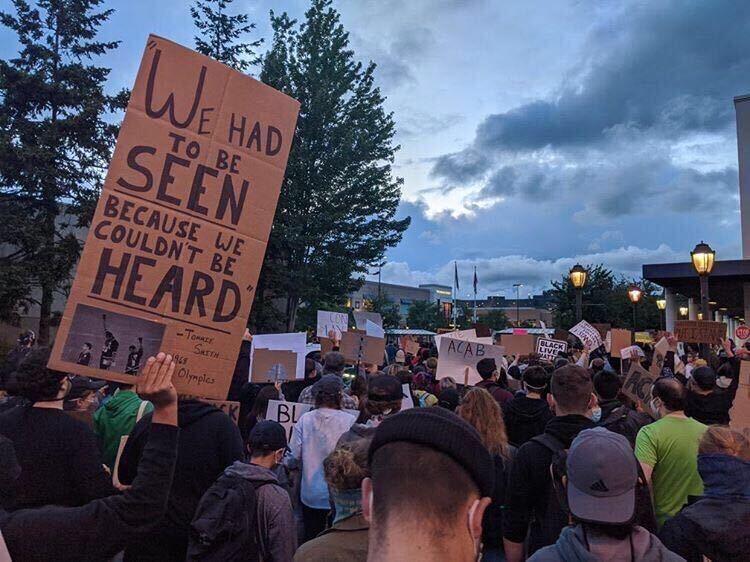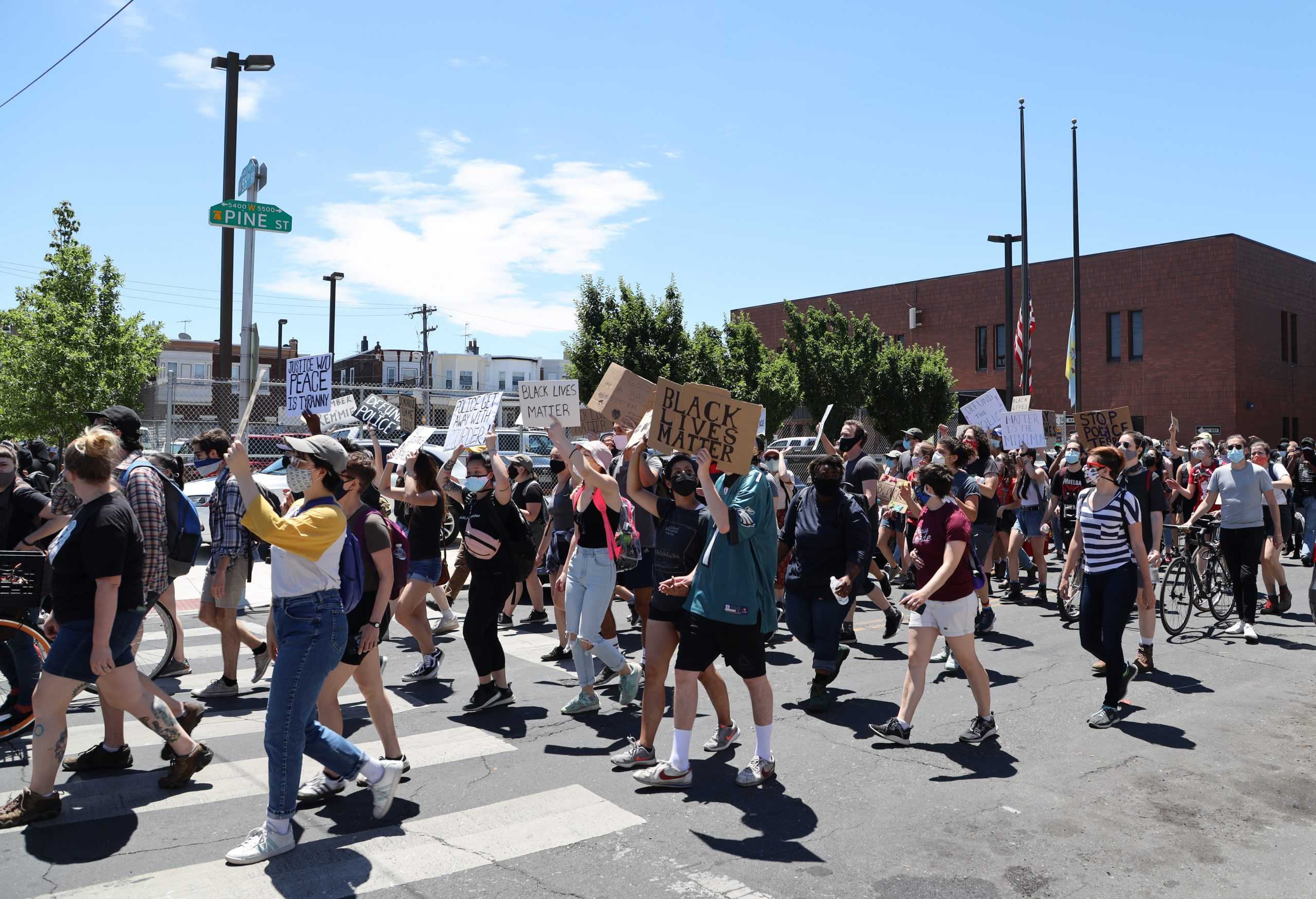Since May 29, hundreds of thousands of Americans across the country have taken to the streets of their cities and towns protesting against police brutality and systemic racism in the U.S. Among those millions are many current St. Joe’s students and alumni, some on the streets and others organizing from their homes.
Aliyah Stokes ’20, member of St. Joe’s Black Student Union (BSU), organized a protest on Hawk Hill on June 4 with help from her sister, Taylor Stokes ’22, BeCivil co-founder. Zoë Welsh ’22, BeCivil member, spent her week dodging rounds of tear gas and flash bombs outside of The White House in Washington, D.C. Matt Haubenstein’15, M.A. ’19 joined protests in his hometown of Philadelphia. BSU member Alyvia Benson ’22, is selling BSU t-shirts to support the Black Lives Matter (BLM) movement. They may represent only five of millions of individuals in the movement, but they are all leaving their mark on a week that will go down in history.
Hawk Hill
On June 4, Aliyah Stokes ’20 and approximately 70 St. Joe’s students began marching from Overbrook Station, up City Avenue towards campus.
The group, mainly dressed in black, marched through campus to Michael J. Hagan ’85 Arena before returning to Villiger Lawn outside of the Chapel of Saint Joseph. All of the protesters kneeled there for eight minutes and 46 seconds to remember George Floyd, who was killed by Minneapolis Police Officer Derek Chauvin.
“I really wanted to be a part of something that felt impactful,” Aliyah Stokes said. “Instagram posting is one thing, but I wanted to get involved. I felt that I had to do something for the community.”
For many who attended, the time kneeling on the ground deepened their understanding of the suffering Floyd endured.
“Halfway through people started crying,” Taylor Stokes said. “People grieved for the Black community.”
Asia Whittenberger ’22, another BeCivil member, used the march back to Overbrook Station as a time to reflect.
“The work to end racism is not only the Black community’s work to do,” Whittenberger said. “It takes everybody to want to learn to want to be a better person for themselves, and for their Black brothers and sisters. The protests are happening for a reason: systemic racism has permeated the U.S. since its origins.”
Washington D.C.
In the nation’s Capital, Zoë Welsh ‘22 spent her week participating in protests in Lafayette Square outside The White House, recently renamed Black Lives Matter Plaza by D.C. Mayor Muriel Bowser. Welsh and her friends started DC Protest Aid & Info, a protest donation account on Instagram.
“We’ve been doing shifts, dropping supplies based on demand. Water was donated a lot, and my friends and I drove around to find goggles, heat resistant gloves and masks,” Welsh said. “Every day it got bigger. More people came to donate, to deliver.”

On the evening of June 1, Welsh’s first day outside the White House, she said law enforcement fired tear gas and flash bombs at peaceful protesters. It happened at 6:30 p.m. while her group was handing out supplies to protesters. Protesters thought there was enough time to leave before the 7 p.m. curfew according to Welsh.
“It came out of nowhere,” Welsh said. “People were running, we were all being pushed back. It was 12 rounds of tear gas and flash bombs within five minutes. We lost a friend in the front and she said she was almost trampled.”
According to news stories, law enforcement officers had set off flash bang explosions and fired tear gas to clear a path for President Donald Trump to walk to the grounds of St. John’s church where he held a bible in his hand for a photo opportunity. No police agency would confirm the use of tear gas on protesters according to media reports.
“It was appalling to see people deny what actually happened,” Welsh said. “There was tear gas, and I had to give someone milk because they got it in their eyes. It’s an abuse of power, they were hurting peaceful protesters.”
Philadelphia
Matt Haubenstein ‘19, from the Port Richmond neighborhood of Philadelphia, said he joined the protests alongside fellow Philadelphians on June 6, one of the largest to take place in the city.
“I went because I had to,” Haubenstein said. “I couldn’t be silent. And I shouldn’t be silent. I have to be out here, I have to be a part of this.”
Haubenstein, who is white, said his decision to show outward support for the Black community may not have been as strong, or present at all, without his St. Joe’s education. He said he came to St. Joe’s ignorant about the problems of the world.

“Being at St. Joe’s, I came to realize the error of my ways,” Haubenstein said. “I wanted to educate myself not to be ignorant, to understand more.”
Haubenstein has made an effort in the past few weeks to understand and educate himself on the Back Lives Matter movement.
“The past week and a half I haven’t gone to bed really at all,” Haubenstein said. “I’ve been up until three, four in the morning just taking in all of the information I can.”
Seattle
On the other side of the country, in Seattle, Washington, Chrissy Szostak ’14 said she also educated herself in order to better support the BLM movement. After graduating from St. Joe’s, she lived in the southern U.S., where she “laid witness to racial injustice as the Black Lives Matter movement was gaining traction.”
Szostak said she wasn’t sure her voice was powerful enough to make an impact on the movement. Until this year, that is, when Szostak said she heard something at the first protest she attended.
“A speaker there gave this assignment to white allies: ‘It is your privilege and your power that you have been given that you must bring to the table to help us shift things,’” Szostak said.
Since then, Szostak has attended two more demonstrations in Seattle, and believes that it is a necessary sacrifice for change.
“Protests have been a unifying and empowering component of this movement, getting people’s attention that change needs to happen,” Szostak said. “But there’s much more to be done. Even amidst the pandemic.”

Moving Forward / Hawks at Home
Back in Philadelphia, St. Joe’s Black Student Union (BSU) has been supporting the movement by sharing educational resources and promoting support for the BLM movement on social media. The BSU partnered with University Tees to sell “SJU Hawks Stand with Black Lives Matter” t-shirts. Alyvia Benson ’22, BSU member, organized the sale.
“We thought we should do this since many students don’t know exactly what to do or where to go to help,” Benson said.
The BSU’s executive board met and discussed what message they wanted on the shirts and how they wanted to design it. They landed on a shirt with a BSU logo and the message “Black Lives Matter, Hawks With And For Others” on the back. Proceeds will go to the NAACP’s national chapter.
“We chose that because NAACP is for the advancement of Black people, and it encompasses all the things that align with our views,” Benson said.
Beyond the recent spike in protests and donations, Taylor Stokes said it should not take a tragedy or a racial slur on campus for the St. Joe’s community to engage in this sort of dialogue. Instead, she said, they should be proactive in their approach to these conversations.
“When are we keeping this conversation going?” Taylor Stokes asked. “When can we normalize this conversation about race?”
Aliyah Stokes said what the St. Joe’s community should take away from the nationwide protests is that many of its members want change.
“It took me, a student, to start this,” Aliyah Stokes said. “[St. Joe’s] should take the message that students care, put some resources towards this, donate, do a little more than just a statement or a post online.”
Links to resources to support and learn more about the BLM movement can be found here: https://www.sjuhawknews.com/resources-to-support-and-educate-on-the-black-lives-matter-movement/














































